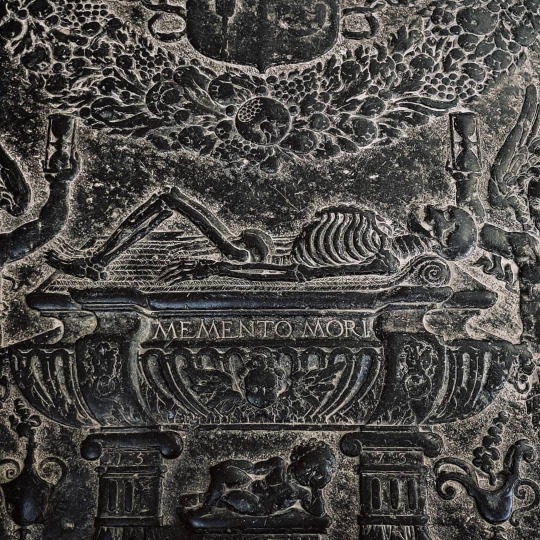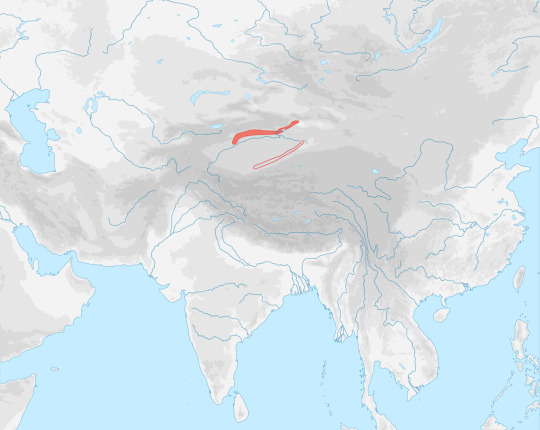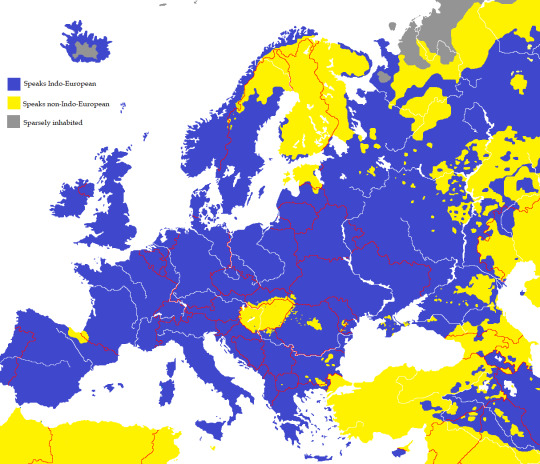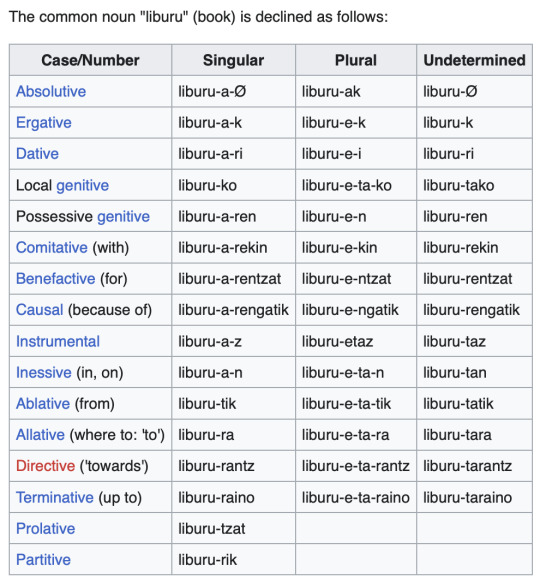#Indo-European languages
Photo

Indoeuropean languages in Europe
Historical Roots: The Indo-European language family is believed to have originated in the Eurasian Steppe around 4000-2500 BCE. From there, groups of speakers migrated to various parts of Europe, contributing to the linguistic diversity of the continent.
by hunmapper
Language Diversification: Indo-European languages in Europe have evolved into numerous branches and sub-branches. Some of the major branches include:
Romance Languages: Descendants of Latin, including French, Spanish, Italian, Portuguese, and Romanian.
Germanic Languages: Including English, German, Dutch, Swedish, and others.
Slavic Languages: Such as Russian, Polish, Czech, and Bulgarian.
Celtic Languages: Including Irish, Scottish Gaelic, and Welsh.
Hellenic Languages: Mainly Greek.
Baltic Languages: Such as Lithuanian and Latvian.
Indo-Iranian Languages: Including Hindi, Bengali, and Persian.
Cultural Significance: Indo-European languages have played a pivotal role in shaping European culture, history, and literature. Greek and Latin, for instance, have had a profound influence on science, philosophy, and the development of the Roman Empire.
Language Revival: Some Indo-European languages in Europe, such as Irish and Welsh, have experienced language revival efforts in recent decades. These efforts aim to preserve and revitalize languages that were declining in usage.
Language Contact: Due to centuries of contact and migration, many Indo-European languages have borrowed words and phrases from each other. This phenomenon, known as linguistic borrowing, has enriched the vocabulary and expressions of these languages.
182 notes
·
View notes
Photo

#memento mori#skeleton#dead#death#skull#latin#text#quotes#Indo-European languages#tomb#tombstone#photo#random
83 notes
·
View notes
Text
People and their synonyms (popular, etc.): Essay

Once upon a time, there was a band called The Village People, and they had hit songs like "YMCA" and "In the Navy," which were covered in Japan by Hideki Saijo and Pink Lady. In that sense, they were a worldwide band, but they were gay, or what we now call LGBTQ. If you look at it that way, you can say that the YMCA (Youngman Christian Associate) and the Navy (Navy) were mostly male-dominated, and indeed hotbeds for LGBTQ. Well, the word "people" in the band's name is learned in Japanese junior high school English, but what is this word?
Speaking of people, former Beatles member John Lennon sang "Imagine", with lyrics like "Imagine all the people". I will come. "People" has a very wide range, starting from the family unit that has a relationship with the parents, to the people, to the ethnic group. Lennon probably sang from the smallest unit of the family to the largest unit of the ethnic group.
(Note: people is a noun that does not have a plural form.)
Unfortunately for me, I couldn't figure out the etymology of the word "people" even when I looked up this electronic dictionary or my paper dictionary. It may be too simple to be decomposed... But I brought a word that seems to be related to this word.
That is popularity and popularism. Popular is the biggest example of "popular, reputable". Other meanings include "of the people, of the people, of the masses."
Populism is "populism (which claims to represent the interests of the people). This word usually does not have a good meaning.
The two words "People" and "popular" can be said to have the same etymology because the three consonants "p", "p", and "l" are commonly seen in short words and have the same meaning.
Words of the Day: Indo-European languages do not have a convenient way to clearly show the relationship between words like the radicals of Chinese characters. For example, the Alps are white mountains, and protein (albumin) is egg white. Alp and alb mean white.
11 notes
·
View notes
Link

2 notes
·
View notes
Text

The French word for a werewolf is loup-garou. Etymologically, this compound is pleonastic: garou means 'werewolf' and loup means 'wolf'. It's also hybrid: loup stems from Latin lupus whereas garou was borrowed from West Germanic *werwulf. Click the image for more.
#historical linguistics#linguistics#language#etymology#english#latin#french#old french#proto-germanic#proto-indo-european#proto-italic#proto-west germanic#lingblr#werewolf#werewolves
987 notes
·
View notes
Note
Do you have any thoughts on the translation scene in Goncharov? I haven't seen a lot of people talking about it but it's a pretty pivotal scene and given that what they're doing is not dissimilar to a conlang imo i figured you might have some good insights
*sigh*
I figured someone was going to ask this eventually...
So listen, the whole translation scene in Goncharov is not technically conlang-related. It's actually even more brilliant, but it's hard to explain.
Since the tutor doesn't speak Russian and the nurse only speaks Italian, the aphasiac Soviet spy has to use an impromptu series of hand gestures to indicate that he either does or doesn't understand. I mean, you can glean that from the subtitles, so that's no big revelation.
But this is where it gets weird and...I mean, linguistically controversial, to say the least, but it was the 70s.
As the tutor and the nurse attempt to communicate with him and each other, they begin to winnow down their vocabulary to words that are cognate between Italian and Russian. And through this back and forth, the languages seem like they're blending, but what they're actually doing is reversing the sound changes of Italian and Russian until they both end up, improbably, at Proto-Indo-European. It's like something you'd see in Fantasia, but aural! It's...utterly bizarre.
And, of course the final word that the nurse and the tutor utter simultaneously, the one that brings the spy to tears, is *bʰewdʰ- "awake, aware"—which, I mean, knowing how the rest of the movie goes...yeah. Bombshell. And it's crazy to me that they didn't subtitle it! Like, you pretty much have to be a PIE scholar to get that, and the entire subplot hinges on it! I mean, bold isn't the word for it. Unfathomable. Cannot believe they got away with that...
Rumor has it that Morris Halle consulted on the film, but he's adamantly refused to talk about. (For years, he'd end all his guest lectures with, "Are they any questions about anything other than Goncharov?") He never once confirmed whether or not he was involved (of course, he wasn't credited, but that wouldn't be unusual for the time even if he was involved).
I can see why you'd think it would be a conlang, but the reverse-engineered sound changes were so precise, and the whole thing so by the book, that there really wasn't any actual invention. It was all Indo-European!
#goncharov#conlang#language#pie#indo-european#proto-indo-european#film#linguistics#morris halle#language evolution#historical linguistics
3K notes
·
View notes
Text
Indo-Europeans be like what do you mean you can't conjugate this verb? It's a regular i-stem verb of the ua subclass of the eu sub-sub class of the ye sub-sub-subclass that nazalizes, palatalizes, and undergoes anywhere from 17 to 30 different forms of umlaut simultaneously depending on what conjugation you're using and gets replaced with a completely different verb when it's passivized!
#linguistics#linguistic#languages#shitpost#linguist shitpost#lingblr#indo european#indo european languages
337 notes
·
View notes
Text
Tocharian
Around 3,000 BCE, speakers of an early branch of the Indo-European languages decided to go for a little hike, and wound up all the way in South Siberia.

A few thousand years later, scholars discovered manuscripts in northwestern China dating to 500–800 CE that were shown conclusively to be written in a language from an early branch of Indo-European. They named this language Tocharian.

The discovery of Tocharian upset decades of research on ancient Indo-European languages and revitalized interested in them for two reasons:
Nobody even suspected that another branch of Indo-European existed, let alone in China’s Tarim Basin.
It was previously thought that the Indo-European languages were divided into eastern and western groups, based on whether the /k/ sound had changed to an /s/. The western languages that retained the /k/ were called centum languages (the Latin word for ‘hundred’, pronounced with an initial /k/), while the eastern languages with /s/ were called satem languages (the Avestan word for ‘hundred’). Yet Tocharian was a centum language sitting further east than almost any other language in the family. (Linguists later hypothesized that the centum-satem split wasn’t so much an east-west split as it was a spread of /s/ from the center of the language family outward, a change which didn’t reach the furthest members of the family).

Tocharian was written in a variant of Brahmi; here’s a sample of Tocharian script on a wooden tablet:

If you really want to challenge yourself, here’s a problem about Tocharian from the International Linguistics Olympiad:
#Tocharian#linguistics#language#historical linguistics#Indo-European#history#archaeology#China#Siberia#lingblr#langblr
248 notes
·
View notes
Text
Review of The Horse, the Wheel, and Language: How Bronze-Age Riders from the Eurasian Steppes Shaped the Modern World by David W. Anthony

I will be upfront, it is a very technical book. If you are not well versed in the anthropological categorizing of cultures and time periods of the areas being discussed it can be very difficult to keep up with the more finite points the author is making. That being said, I had never heard of any of the specific cultures being discussed in the Danube Valley and was still able to enjoy this book and its well put together analysis of various aspects of language, culture, technological developments and shifts in behaviors and place.
If you are especially interested in any of the major themes this book discusses (which is in all honesty is an extensive list including but not limited to; the development of Indo-European language, the time periods and locations as well as likely motivation for domestication of various livestock types, the cultural effects of technological developments on the peoples of the Eurasian Steppes and their migration/trading patterns) I do highly recommend. It is heavy reading but extremely illuminating.
#The horse the wheel and language#David W Anthony#historical anthropology#anthropologist#anthropology#ancient languages#language#historical linguistics#linguistics#proto indo european#indo european#steppes#eurasian#eurasian steppe#horse#horses#husbandry#burials#Cattle#sheep#book review
158 notes
·
View notes
Text
there is no such thing as either “ a European language” or “European phonology” as a linguistic category btw. Europe is a physical entity but also a constructed idea with indefinite boarders; it is not a linguistic category
#Like on many levels. I think what they might mean sometimes is Indo-European but that’s a language family#And it uh. Includes Farsi and Bengali
125 notes
·
View notes
Photo

A more accurate/detailed map of Indo-European and non-Indo-European languages in Europe
274 notes
·
View notes
Text

are basque speakers doing okay?
116 notes
·
View notes
Text
During excavations at the ancient Hittite capital, Hattusa, archaeologists have found a clay tablet that contains a previously unknown language!
107 notes
·
View notes
Link
4 notes
·
View notes
Text
friends I found a link where you can learn to read ancient languages (for free)
107 notes
·
View notes